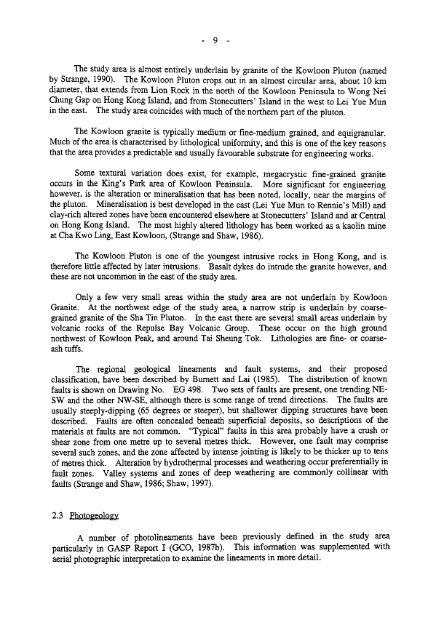miscellaneous planning standards and guidelines - HKU Libraries
miscellaneous planning standards and guidelines - HKU Libraries
miscellaneous planning standards and guidelines - HKU Libraries
Create successful ePaper yourself
Turn your PDF publications into a flip-book with our unique Google optimized e-Paper software.
The study area is almost entirely underlain by granite of the Kowloon Pluton (namedby Strange, 1990). The Kowloon Pluton crops out in an almost circular area, about 10 kmdiameter, that extends from Lion Rock in the north of the Kowloon Peninsula to Wong NeiChung Gap on Hong Kong Isl<strong>and</strong>, <strong>and</strong> from Stonecutters' Isl<strong>and</strong> in the west to Lei Yue Munin the east. The study area coincides with much of the northern part of the pluton.The Kowloon granite is typically medium or fine-medium grained, <strong>and</strong> equigranular.Much of the area is characterised by lithological uniformity, <strong>and</strong> this is one of the key reasonsthat the area provides a predictable <strong>and</strong> usually favourable substrate for engineering works.Some textural variation does exist, for example, megacrystic fine-grained graniteoccurs in the King's Park area of Kowloon Peninsula. More significant for engineeringhowever, is the alteration or mineralisation that has been noted, locally, near the margins ofthe pluton. Mineralisation is best developed in the east (Lei Yue Mun to Rennie's Mill) <strong>and</strong>clay-rich altered zones have been encountered elsewhere at Stonecutters' Isl<strong>and</strong> <strong>and</strong> at Centralon Hong Kong Isl<strong>and</strong>. The most highly altered lithology has been worked as a kaolin mineat Cha Kwo Ling, East Kowloon, (Strange <strong>and</strong> Shaw, 1986).The Kowloon Pluton is one of the youngest intrusive rocks in Hong Kong, <strong>and</strong> istherefore little affected by later intrusions. Basalt dykes do intrude the granite however, <strong>and</strong>these are not uncommon in the east of the study area.Only a few very small areas within the study area are not underlain by KowloonGranite. At the northwest edge of the study area, a narrow strip is underlain by coarsegrainedgranite of the Sha Tin Pluton. In the east there are several small areas underlain byvolcanic rocks of the Repulse Bay Volcanic Group. These occur on the high groundnorthwest of Kowloon Peak, <strong>and</strong> around Tai Sheung Tok. Lithologies are fine- or coarseashtuffs.The regional geological lineaments <strong>and</strong> fault systems, <strong>and</strong> their proposedclassification, have been described by Burnett <strong>and</strong> Lai (1985). The distribution of knownfaults is shown on Drawing No. EG 498. Two sets of faults are present, one trending NE-SW <strong>and</strong> the other NW-SE, although there is some range of trend directions. The faults areusually steeply-dipping (65 degrees or steeper), but shallower dipping structures have beendescribed. Faults are often concealed beneath superficial deposits, so descriptions of thematerials at faults are not common. "Typical" faults in this area probably have a crush orshear zone from one metre up to several metres thick. However, one fault may compriseseveral such zones, <strong>and</strong> the zone affected by intense jointing is likely to be thicker up to tensof metres thick. Alteration by hydrothermal processes <strong>and</strong> weathering occur preferentially infault zones. Valley systems <strong>and</strong> zones of deep weathering are commonly collinear withfaults (Strange <strong>and</strong> Shaw, 1986; Shaw, 1997).2.3 PhotogeologyA number of photolineaments have been previously defined in the study areaparticularly in GASP Report I (GCO, 1987b). This information was supplemented withaerial photographic interpretation to examine the lineaments in more detail.
















